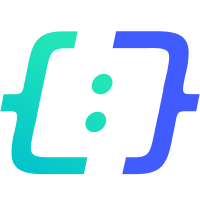Since Compound, a decentralized, blockchain-based protocol running on the Ethereum network, launched the liquidity mining (also known as yield farming) program, the liquidity mining model has been used by various decentralized finance (DeFi) protocols to accumulate initial liquidity and offer incentives to users to bootstrap liquidity. However, the latter only attracts speculators rather than users. Moreover, a growing number of liquidity mining projects boasting a high annual percentage yield (APY) have turned out to be a Ponzi scheme. After the liquidity mining boom recedes, the token economy and DeFi protocols are left in chaos. Good cryptos have been "mined, withdrawn, and sold", and DeFi has gradually lost its popularity after failing to promise an alluring yield. Liquidity mining did draw attention, but did not pave a path for sustainability. Finding the next considerable, stable source of yield has become an important topic for DeFi to tide over hard times from crypto winter to DeFi summer.
Real Yield
Real yield is a new hot topic in the world of DeFi. Roughly speaking, it means evaluating the fundamentals of a DeFi project and its sustainability from the perspective of cash flow. Due to their solid user base and fee income, protocols such as the traditional Uniswap and the emerging GMX will not only have a greater chance of survival and development in a long bear market, but also provide token holders with "real yield".
However, most of the "real yield" of such projects lays the groundwork for financial transactions in cryptocurrencies. In other words, it serves as a platform for speculators. In most cases, it only involves the funds and users in the crypto circle, leaving few opportunities open to those users outside the circle or potential blockchain users. Generally, most of the real yield exists to serve the purpose of financial speculation. Due to the low diversity of yield sources and the high relevance to the blockchain market, it has great difficulty providing stable cash flow for investors.
Real World Asset (RWA)
Another concept, Real World Asset (RWA), has been proposed to build connections between DeFi and the real world. Under a tokenized mechanism, RWA generates cash flow which is used to distribute yield in cryptocurrency to liquidity providers of DeFi protocols. Currently, the size of the global lending market is expected to reach about $7 trillion, while the total value locked (TVL) across all DeFi platforms is only $65 billion. Nowadays, a growing number of protocols and traditional institutions are connecting the real world with DeFi in their own ways or via crossover cooperation.
Source: https://www.globenewswire.com/en/news-release/2022/07/20/2482454/28124/en/11-2-Billion-Worldwide-Lending-Industry-to-2031-Identify-Growth-Segments-for-Investments.html
https://defillama.com/
Tokenization of RAW
As far as the existing protocols are concerned, one of the simplest ways of realizing RWA & DeFi is to tokenize RWA. The stablecoins most familiar to users are tokenized versions of US dollars. For example, Circle issued USD Coin (USDC) by backing every USDC with one dollar or an asset with an equivalent value to ensure 1:1 dollar liquidity for USDC at all times. There are other types of stablecoins, such as Euro Coin (EUROC). Commodity gold is tokenized on a relatively large scale, and such tokens include PAX Gold (PAXG) issued by Paxos Trust and Tether Gold (XAUt) issued by Tether. The value of these gold-backed tokens will always be equal to the fixed amount of gold. These RWA tokens make real-world assets tradable on a blockchain, so blockchain users can invest/hold RWA in the form of tokens.
In addition to commodity tokens, more and more protocols are trying to tokenize yield-bearing RWAs. Compared with TradFi, the RWA & DeFi cooperation has the following benefits:
1) Improving efficiency: The 24-hour smart contract settlement of the blockchain can help to streamline the traditional RWA. In contrast, the financing of traditional RWA may involve many intermediaries, which means time-consuming cooperation.
2) Lowering entry barriers: Traditional RWA financing sets high requirements for investors due to risk tolerance. Only accredited investors are allowed to invest in many types of assets, and the investment amount is also limited (for example, the initial investment for private placement is set at RMB 1 million in China). DeFi removes the limitation and adjusts the entry barrier flexibly.
3) Diverse yield: Apart from cryptocurrencies and crypto derivatives, more diversified sources of yield are available in the world of DeFi. Many sources of yield are weakly related to the blockchain industry, promising greater stability to DeFi.
Centrifuge
Centrifuge is taking wide-ranging approaches in this regard. It is advancing the tokenization of various real-world loans, including loans to fintech start-ups, loans to commercial real estate, commercial bills and accounts receivable. These credit-related, yield-bearing loans are tokenized. Considering the tokenization of RWA involves procedures from compliance to on-site due diligence as well as cross-border coordination, Centrifuge has launched most of its tokenized RWA products in cooperation with other protocols that have real projects and can provide support in terms of technologies and platforms. Tinlake, with a TVL of $86 million, is Centrifuge's RWA marketplace where various cooperative tokenized RWA products of Centrifuge can be found, such as the revenue-based financing pool built together with Fortunafi (https://www.fortunafi.com/). The revenue-based financing pool is a loan that small and medium-sized enterprises (SMEs) agree to pay back over time by promising a chunk of their future revenue to the financier.

In addition, the token of this financing pool is classified as Drop token for the senior tranche or Tin token for the junior tranche. Just like traditional finance, it also adopts the concept of the tranche, which means the repayment order could be different (in the case of a default, Tin holders take second priority to Drop holders when money flows from borrowers back to funders). TIN holders enjoy a much higher yield. There are also requirements for the investment amount. Drop requires a minimum investment amount of 5,000 DAI, while Tin requires 50,000 DAI.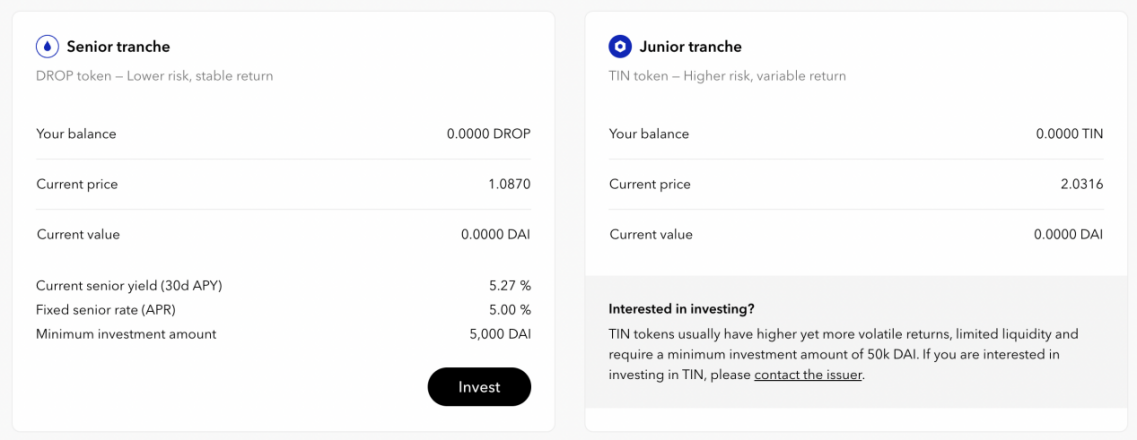
So far, Centrifuge has in-depth cooperation with Aave and MakerDAO. Built on Centrifuge and the Aave Protocol, the RWA Market enables Aave depositors to participate in some screened projects of Tinlake without an investment threshold. The cooperation between Centrifuge and MakerDAO allows a real estate project to mortgage its housing assets to mint DAI.
Credix
Credix is making similar attempts. With a TVL of $23 million at present, it is dedicated to financing fintechs in a way similar to Centrifuge's tokenization. However, Credix adopts a more rigorous approach to compliance. Its official website refuses users using VPN to log in to DApp, and only accepts IP addresses from specific countries even after VPN is closed.
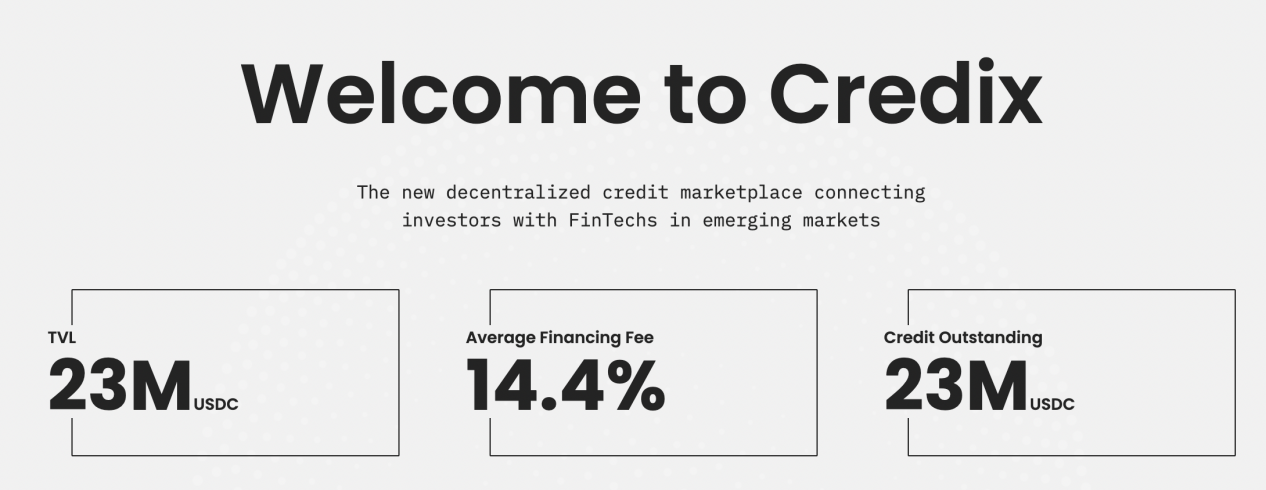
Goldfinch
Goldfinch is also working on the tokenization of RWA, but differently. In most cases, Goldfinch directly cooperates with investment institutions. Instead of financing target enterprises, it serves investment institutions. Specifically, Goldfinch lends the funds of the investors in the pool to these investment institutions, which further invest in the target enterprises. For example, the latest pool built by Cauris and Goldfinch aims to provide loan support for African fintechs. Participants need to go through KYC via Persona (a DID project), including uploading passports and verifying identity.
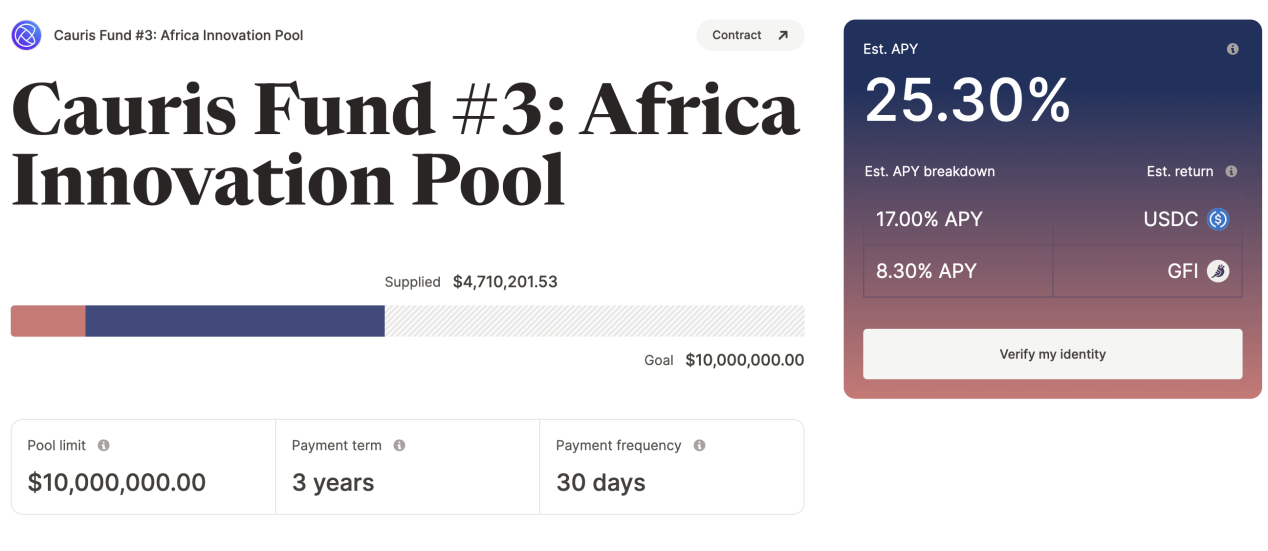
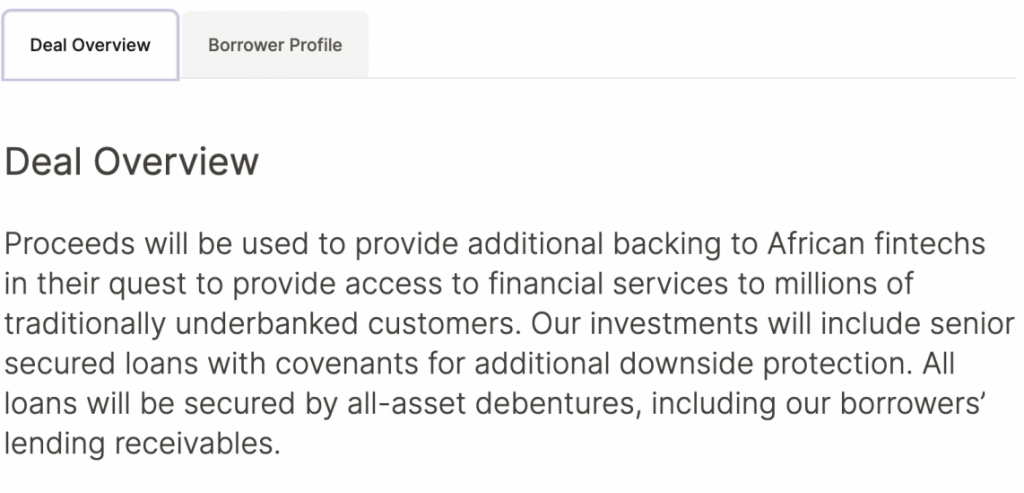
In terms of risk, Goldfinch has advantages, because lending money to financial institutions is less riskier than lending money directly to SMEs. If an SME defaults, Goldfinch's pool will not necessarily have bad debts. Only when those SMEs have serious bad debts and financial institutions have defaulted will the pool has bad debts.
Another thing that makes Goldfinch different from Centrifuge is that it targets different users. Centrifuge favors accredited investors in the traditional sense. Besides adopting the concept of the tranche, it also sets a threshold for investment amount. The minimum investment of junior investors with a high risk is set at 50,000 DAI. Investors are supposed to approach business personnel for investment, which cannot be contracted. Goldfinch prefers retail traders. It does not require a minimum investment and all investment behaviors are contracted, which makes investments more efficient and faster.
Maple Finance
In terms of lending volume, Maple Finance is the largest protocol in the category. Additionally, it has issued nearly $2 billion worth of RWA lending products on the ETH mainnet and Solana. On Maple, lending is done through credit. For example, the largest loan pool on Maple has offered credit to Maven11, a blockchain investment company, and loans are provided through the credit line granted to Maven11. On Maple, instead of ordinary retail investors, most borrowers are blockchain-related companies. They also provide a portion of the collateral based on their credit rating.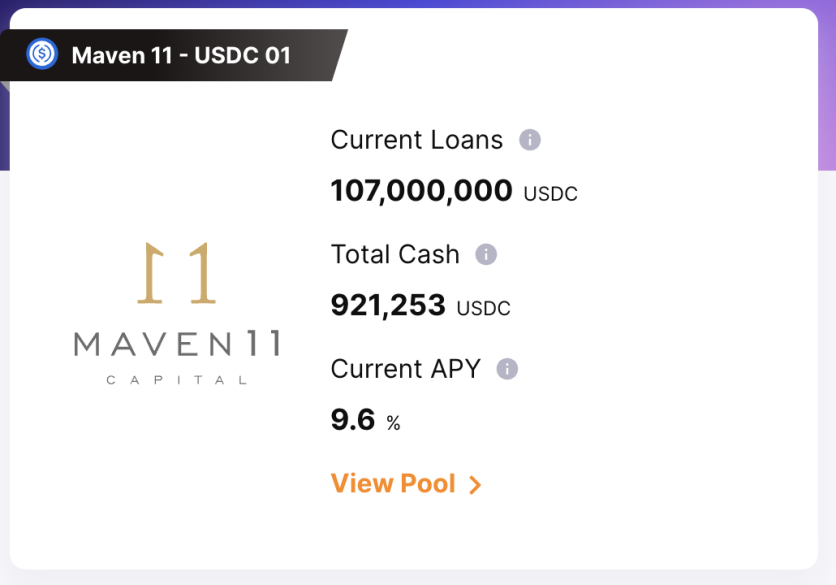
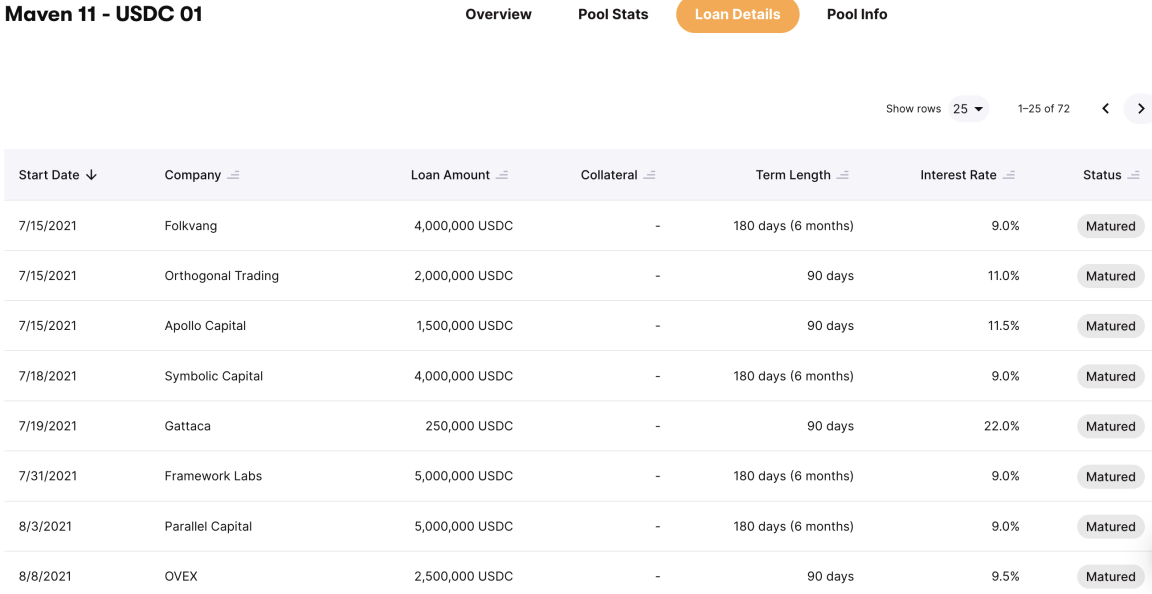
At the moment, Maple focuses on the large-scale financing of eligible companies, which allows the project to scale up within a shorter period. Meanwhile, through a model that resembles a distribution agency, Maple grants credit to institutions, and loans are provided by such institutions, which reduces the risk of individual default. However, it should be noted that despite the large scale of the loans, both lenders and borrowers on Maple are companies like market makers and blockchain VCs that are closely correlated with the blockchain industry. This means that the protocol’s revenue source might also be closely correlated with blockchain, and investors will suffer losses in the event of massive defaults due to systemic risks in the blockchain space. At the same time, Maple has no compliance requirements for investors (users). In other words, when depositing assets into a pool on Maple, no KYC operations are required, and anyone can deposit any amount of tokens into the pool, which probably explains Maple’s large volume.
Tokenization of financial assets
The direct tokenization of real-world securitized products is also a way to introduce RWA interest-earning assets. For compliance reasons, such service providers are mostly centralized institutions. For example, DBS FIX Marketplace, founded by DBS Bank, is a fully digital and automated fixed-income execution platform; the app also manages legal, operational, and sales-related transactional data flows and documentation. The platform enables investors to participate with a minimum ticket size of $10,000 (versus $250,000 for traditional bond issuance). Sygnum’s tokenization solution covers the complete security life cycle — from primary issuance and settlement to custody and secondary trading — making the process more efficient and transparent through digitization.
Conclusion
To sum up, the combination of DeFi and RWA has the potential to attract users and diversify revenue, which might be a turning point that will lead to another DeFi boom. On-chain TVL of the relevant projects also looks promising, as innovative protocols have explored a growing number of feasible solutions. That said, compared to the scale of real-world financial markets, the combination of DeFi and RWA is still far from achieving mass adoption. Apart from the lack of mature infrastructures, the category is mainly restricted by compliance limits. Blockchain features borderless participation. This makes it difficult to control the price and risk of RWA products on the chain, which should be regulated by a new set of consensus rules. More institutions and users will flock to the category only when we adopt mutually recognized and reasonable rules, which will lead to the exponential growth of RWA’s on-chain adoption.


